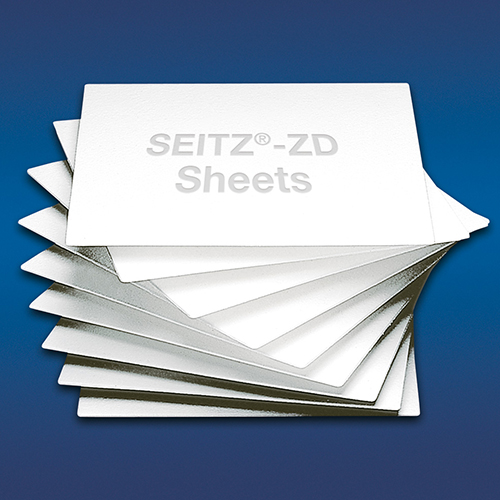What is Seitz ZD media?
Seitz ZD media is based on a new depth filter sheet formulation which contains 100% pure cellulose fibers. Compared to classical DE sheets, the fine pore structure is obtained by using a new manufacturing process that fibrillates the cellulose fibers to produce a sub-micron structure.
What are the major benefits of the Seitz ZD Sheets compared to classical DE sheets?
- > 90% less drip loss
- Less color and aroma stripping
- Higher purity
- Significantly less extractables (esp. less heavy metals like As, Fe, Al…)
- Higher microbiological retention
- Improved rinsing characteristics
- 50% less water consumption for rinsing prior to filtration
- 50% less water consumption for regeneration
- No inorganic material: sheet media can be composted or incinerated without remaining ash, bio-degradable
- Very low impact on aroma, color and other value adding components, can therefore be used for the filtration of high quality liquids
- Total service life at least as good as standard sheet media (can withstand identical sanitization/ flow conditions)
- No health risk as the ZD media does not contain inorganic crystalline substances
How does the service life of the Seitz ZD media compare to classical DE sheets?
The service life of the Seitz ZD media is at least on the same level as classical DE sheets. If regeneration process is possible, it can exceed classical DE sheet by at least 20%.
How many sheet grades are available?
There are 4 sheet grades available:
- Seitz EK ZD
- Seitz KS 80 ZD
- Seitz K 100 ZD
- Seitz K 250 ZD
Is Seitz ZD media food contact compliant?
Yes, Seitz ZD is food contact compliant. Please refer to the Pall website for a Declaration of Compliance to specific National Legislation and/or Regional Regulatory requirements for food contact use.
Which flowrates are recommended?
Flowrates defined for Seitz ZD media sheets are same as for classical DE Sheets.
Which sanitization methods can be used?
Both hot water and steam sanitization method can be used to sanitize Seitz ZD media. How does the colloidal retention of Seitz ZD media compare to classical DE sheet media? Depth filter sheets are often used to protect membrane cartridges against colloidal clogging. The sub-micron structure of DE is the prime reason for the colloidal retention capacity of DE sheets. Comparison trials have shown that Seitz ZD sheets have a lower colloidal retention capability.
On the other hand, the lower colloidal retention helps to preserve wine components that are important for the mouth-feel of high quality wines. Although, for wines that have very high colloidal content, it is recommended to use DE sheets as prefilter prior to membrane filters to avoid accidental colloidal membrane clogging.
Final membrane cartridge filters will have a higher colloidal load if pure cellulose sheets are used to protect the membranes.
When I want to filter high quality wines, why is the Seitz ZD Media the preferred choice?
The depth filter sheet matrix of a pure cellulose sheet has a different fine structure compared to sheets that contain DE which reduces the colloidal retention capability. If the pure cellulose sheet is used for high quality wines the colloidal structure of the wine is less affected which has a positive impact on the mouth feel of the wines. This is why high quality wineries use pure cellulose sheets for wine filtration.
How does ion and heavy metal content of Seitz ZD media compare to classical DE sheet media?
DE is a known source of different ions and heavy metals. The ion content of DE sheets is reduced by flushing prior use. This is less relevant for Seitz ZD sheet media as the pure cellulose matrix does not contain ions and heavy metals.
Why is the regeneration of Seitz ZD media easier compared to classical DE sheets?
Based on a different fine structure of cellulose sheets, recovery is easier compared to DE containing sheets. This reduces the total water consumption for flushing and regeneration.
Why does Seitz ZD media show significantly lower (down to zero) drip losses compared to classical DE sheets?
The cellulose content of a depth filter sheet is one main driver for the sealing characteristics of a filter sheet. The higher the cellulose content the higher the sealing effect in the filter press. Wetted cellulose fibers act like a seal as the fibers can be compressed like a silicone seal. DE in contrary is not compressible and which is less beneficial for the sealing character of the sheet media.
How does the urbidity reduction of Seitz ZD media both for 25° and 90° angle detection compare to classical DE sheet media?
The 25° angle turbidity reduction (particles) of Seitz ZD media is comparable to classical DE Sheets. The 90° angle turbidity reduction (colloids) of Seitz ZD Media is a slightly lower compared to classical DE Sheets.
I have a wine that has a very bad filterability. It seems that the wine contains a high amount of colloids and ß-glucane. Which sheet media should be the choice, when the sheet filter is used prior final membrane filtration and subsequent bottling?
DE Sheet filters are the first choice as they show a higher colloidal load capacity and therefore ensure a more significant extension of the service life of final filters.
What are the benefits to use Seitz ZD media instead of DE sheets in beer Filtration?
- The use of Seitz ZD media adsorbs less of the valuable beer ingredients such as hop oils (Monoterpenes and Sesquiterpenes) and bitterns. Color stripping is much lower.
- The ion release of Iron, Arsenic, Lead, Aluminum and other critical heavy metals is reduced to a minimum.
- Cellulose sheet filters show a reduced risk for mold growth.
- The pure cellulose matrix allows reduction of drip losses by 90% and more.



